The Leibniz-IZW is an internationally renowned German research institute. It is part of the Forschungsverbund Berlin e.V. and a member of the Leibniz Association. Our goal is to understand the adaptability of wildlife in the context of global change and to contribute to the enhancement of the survival of viable wildlife populations. For this purpose, we investigate the diversity of life histories, the mechanisms of evolutionary adaptations and their limits, including diseases, as well as the interrelations of wildlife with their environment and people. We use expertise from biology and veterinary medicine in an interdisciplinary approach to conduct fundamental and applied research – from the molecular to the landscape level – in close dialogue with the public and stakeholders. Additionally, we are committed to unique and high-quality services for the scientific community.
+++ Current information on African swine fever: The Leibniz-IZW conducts research on the population dynamics, on models of disease outbreaks in wild boars and on the ecology and human-wildlife interaction in urban areas. African swine fever is a reportable disease in domestic swine and therefor is the purview of the respective federal state laboratories and the Friedrich-Loeffler-Institut (Federal Research Institute for Animal Health) FLI. +++
News
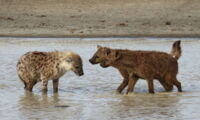
The power of social support – How female hyaenas came to dominate males
In most animal societies, members of one sex dominate those of the other. Is this, as widely believed, an inevitable consequence of a disparity in strength and ferocity between males and females? Not necessarily. A new study on wild spotted hyaenas shows that in this social carnivore, females dominate males because they can rely on greater social support than males, not because they are stronger or more competitive in any other individual attribute. The main reason for females having, on average, more social support than males is that males are more likely to disperse and that dispersal disrupts social bonds. The study by scientists of the Leibniz Institute for Zoo and Wildlife Research (Leibniz-IZW, Germany) and the Institut des Sciences de l’Evolution de Montpellier (ISEM, France) was published in the journal Nature Ecology & Evolution.
Read more … The power of social support – How female hyaenas came to dominate males
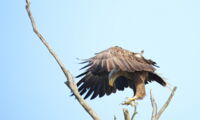
First evidence of fatal infection of white-tailed sea eagles with avian influenza
The most common unnatural causes of death in white-tailed sea eagles are lead poisoning and collisions with trains. During the winter of 2016/2017, however, many white-tailed eagles died in Northern Germany in circumstances unrelated to either cause. Instead, at least 17 white-tailed sea eagles were killed by avian influenza of the highly pathogenic virus subtype H5N8, as a team of scientists from the Leibniz Institute for Zoo and Wildlife Research (Leibniz-IZW) and the Friedrich-Loeffler-Institute (Federal Research Institute for Animal Health, FLI) demonstrated. Avian influenza may become a new threat for this highly protected wild species. The study was published in the scientific journal “Viruses”.
Read more … First evidence of fatal infection of white-tailed sea eagles with avian influenza
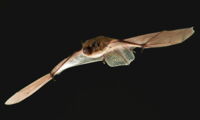
Red light at night: A potentially fatal attraction to migratory bats
Night time light pollution is rapidly increasing across the world. Nocturnal animals are likely to be especially affected but how they respond to artificial light is still largely unknown. In a new study, scientists from the Leibniz Institute for Zoo and Wildlife Research (Leibniz-IZW) in Berlin, Germany, tested the response of European bats to red and white light sources during their seasonal migration. Soprano pipistrelles (Pipistrellus pygmaeus) and, to a lesser degree, Nathusius’ pipistrelles (Pipistrellus nathusii) were recorded more frequently near red LED light, indicating that the animals might be attracted to red light during their migration. In contrast, the scientists did not observe such behaviour near white LED lights.
Read more … Red light at night: A potentially fatal attraction to migratory bats
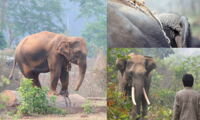
Capturing elephants from the wild shortens their lives
Humans have captured wild Asian elephants for different purposes for more than 3,000 years. This still continues today despite the fact that the populations are declining. An international team of researchers has now analysed records of timber elephants in Myanmar to understand the effects of capture on the survival of the animals. The study shows that even years after capture, the mortality rate of wild-caught elephants remains increased, and their average life expectancy is several years shorter than that of captive-born animals. This increases the pressure on free-ranging populations, if captures from the wild continue, and thus could be unsustainable in the long run. Possible differences between captive-born and wild-captured elephants, as revealed by this study, have important implications but are rarely considered in research and conservation programmes. The results have now been published in the scientific journal Nature Communications.
Read more … Capturing elephants from the wild shortens their lives
-daniel-zupanc_web-vds2ya04kqt4gbd.jpg)
Gene recombination deactivates retroviruses during invasion of host genomes
Most vertebrate genomes contain a surprisingly large number of viral gene sequences – about eight percent in humans. And yet how do exogenous viruses – apparently having invaded from outside – manage to become integrated into the host genome? Answers to this question are provided in a study by an international team of researchers led by Alex Greenwood of the Leibniz Institute for Zoo and Wildlife Research (Leibniz-IZW) in Berlin. Working with the example of koalas, the researchers have now identified key stages in the process, called “endogenization”, by which a host is invaded by exogenous retroviruses. The scientists also uncovered a process by which the host genome mounts a defense against the invaders. The results have now been published in the scientific journal PNAS.
Read more … Gene recombination deactivates retroviruses during invasion of host genomes
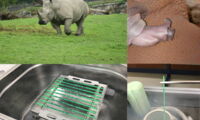
Rhino sperm from the cold – new cryoprotective increases motility of sperm after thawing
A new mixture of cryoprotectives allows for an unprecedented high motility of frozen rhinoceros sperm after thawing, report scientists from the Institute for Zoo and Wildlife research (IZW) in Berlin, Germany. These new cryoprotectives can increase the prospects of utilising assisted reproduction techniques for many endangered wildlife species. The study, based on three rhinoceros species, has been published on 11th July2018 in the journal PLOS ONE.
Read more … Rhino sperm from the cold – new cryoprotective increases motility of sperm after thawing
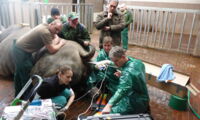
A breakthrough to rescue the Northern White Rhino – First ever hybrid embryo produced outside the womb
Northern White Rhinos (NWR) are functionally extinct, as only two females of this species are left on the planet. An international team of scientists has now successfully created hybrid embryos from Southern White Rhino (SWR) eggs and NWR sperm using assisted reproduction techniques (ART). This is the first, ever reported, generation of blastocysts (a pre-implantation embryos) of rhinos in a test tube. Additionally, the international team established stem cell lines from blastocysts of the SWR with typical features of embryonic stem cells. This breakthrough is published in Nature Communications today.
Press conference - invitation
You are cordially invited to our press conference presenting groundbreaking research results in our international project.




